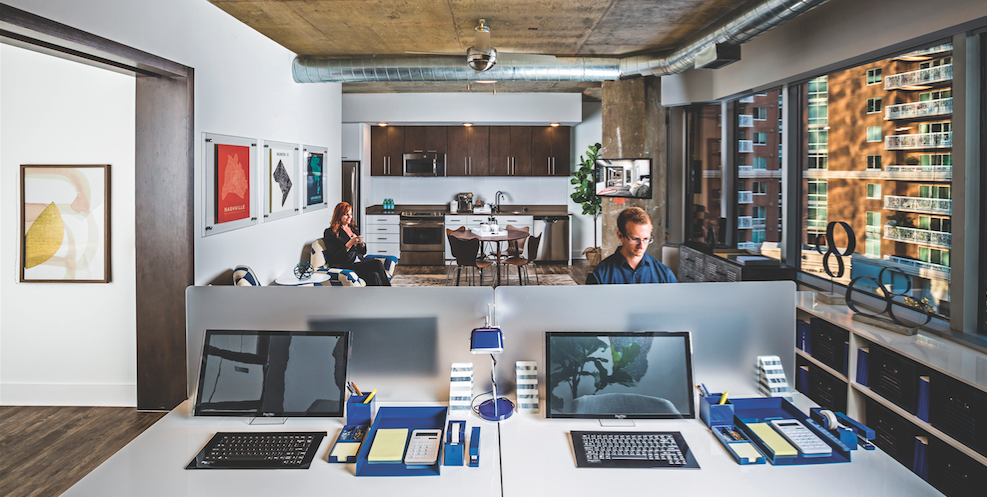The new e-lofts, a 200-unit complex now leasing in Alexandria, Va., owes its genesis to the smartphone. Thanks to our smartphones (and laptops and tablets) we no longer have to be tethered to our cubicles. We can work from practically anywhere. The Census Bureau says 6.8 million Americans—4.6% of the U.S. workforce—work from home. Global Workplace Analytics estimates that 20–25% of U.S. workers do so remotely part time.
The practical effect of the unshackling of the American worker is that traditional downtown and suburban office buildings are bleeding tenants. In Northern Virginia, which includes the city of Alexandria, there are about 150 office buildings with vacancies of 50,000 sf or more, according to the Washington Post. Office rentals in the metro area are flat, even as the region added 66,600 jobs last year.
About three years ago, Conrad Cafritz, Chairman/CEO of Cafritz Interests and the son of legendary Washington, D.C., real estate developer Morris Cafritz, pondered this disturbing scenario. His five decades’ experience in real estate told him that most of these structures were beyond salvation as office properties. Yet most of them were basically good buildings. They were usually in choice locations. They had been the trophy properties in their markets when they first opened their doors. Most had tons of parking, and they usually had “good bones,” structurally speaking. But time and technology had rendered them obsolete.
With all those plusses, Cafritz wondered, why couldn’t these properties be put to better use?
At some enlightened moment in his reverie, Cafritz hit upon a revolutionary idea. Most local jurisdictions in the D.C. area, he knew, permitted mixed-use buildings—office, retail, residential, even hotel—in certain zoning districts, as long as the respective uses were physically separated from one another.
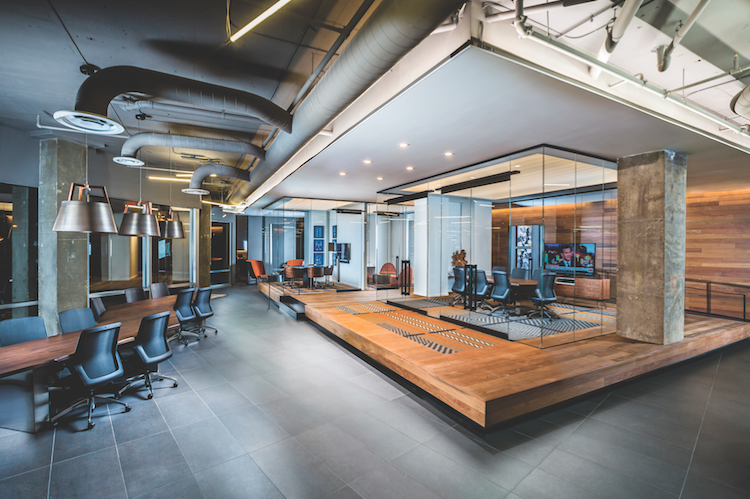 An elevated glassed-in conference room (280 sf, expandable to 410 sf) can be curtained for privacy. “The wood [ipe] brings in a warmer feeling,” says Gensler’s Joanna Shin. “We wanted to avoid a gritty-grungy startup feel, to balance high-end residential with commercial-corporate.” Area at left has workstations with undercounter power/data ports. Flooring: Basaltina stone tile
An elevated glassed-in conference room (280 sf, expandable to 410 sf) can be curtained for privacy. “The wood [ipe] brings in a warmer feeling,” says Gensler’s Joanna Shin. “We wanted to avoid a gritty-grungy startup feel, to balance high-end residential with commercial-corporate.” Area at left has workstations with undercounter power/data ports. Flooring: Basaltina stone tile
What if these old relics could be renovated to allow for three different kinds of uses—Cafritz called them “live,” “live-work,” and “work”? And not just in the same building but—and this was the genius stroke—on the same floor? That could be a game changer. Hundreds of vacant or distressed office buildings could be converted into properties that offered the lessee a choice of three options. Cafritz was well aware that no one in the Washington real estate market—maybe not in the whole country—had ever tried it, but that wasn’t going to stop him.
In 2015, he and Robert M. Seldin, CEO of Novus Residences, a multifamily partnership within Cafritz Interests, purchased a vacant 14-story office building near I-395 in Alexandria. The property, built in 1987, was assessed at $57.4 million; they got it for $20 million. They brought in Lord Aeck Sargent (architect), Gensler (interiors/visioning), and Landworks Studio (landscape design) to turn Cafritz’s vision into reality. Then they marched off to City Hall to plead their case to the local authorities.
REINTERPRETING THE ZONING
The newly acquired property was zoned for high-density mixed use. Both commercial office and multifamily residential were allowed, but only “in a single structure or multiple but integrated and related structures.” In other words, offices and living spaces had to be physically separated from each other.
The developer appealed to the city for a broader interpretation of the ordinance. Novus wanted to meet the needs of three target groups: couples who wanted lots of living space; work-at-home singles and couples; and small businesses of 10 employees or less, which, as Seldin told city officials, make up three-fourths of U.S. companies. Would the city allow a mix of these three uses on the same floor?
Robert Kerns, AICP, Alexandria’s Development Division Chief, says the city was intrigued with the idea, but had to tread carefully. “We’re both a regulatory agency and one that encourages economic investment in the city,” he says. But city officials had good reason to be open-minded. Alexandria already had “a lot of underutilized or vacant space,” says Kerns. The Novus concept might just be a way to turn some of those empty boxes into sorely needed housing and space for emerging businesses.
Negotiations went on (amicably, according to all parties) for several months.
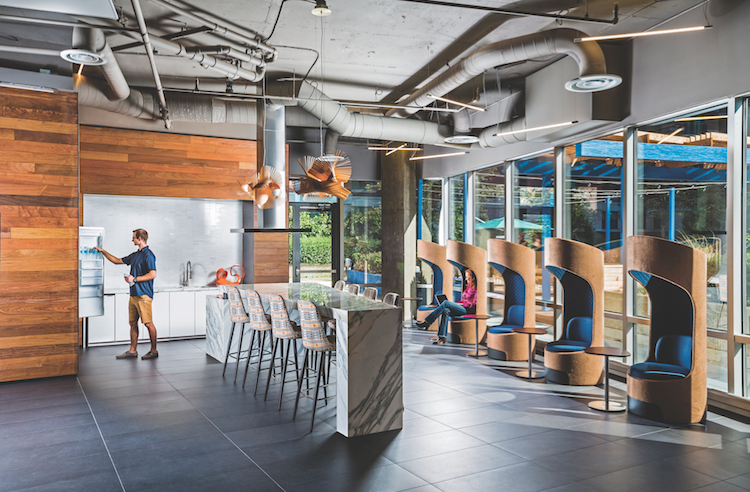 The fully equipped demonstration kitchen can host corporate events, celebrity chef demonstrations, or casual parties. The back door leads to the outdoor patio/grill area. The “lipstick chairs” (right) provide “cones of silence” for individual users. The design team skewed the grid to achieve spatial variety and visual interest.
The fully equipped demonstration kitchen can host corporate events, celebrity chef demonstrations, or casual parties. The back door leads to the outdoor patio/grill area. The “lipstick chairs” (right) provide “cones of silence” for individual users. The design team skewed the grid to achieve spatial variety and visual interest.
The city took the position that it was open to a reasonable interpretation of the “commercial/residential” language of the ordinance, provided all other zoning requirements—particularly as to parking and open space—were met. With 541 slots, the property more than complied with the parking requirements (five spaces per 1,000 sf of area). Counting the 30,000-sf deck roof on the parking structure as open space (OK under the ordinance), the property easily met the 40% open-space minimum.
“It was a new idea, and the city prides itself on being in the forefront of development trends,” says Kerns. “We felt they were meeting the zoning impacts.” But the decision would not reflect blanket city policy. It applied only to the e-lofts application, says Kerns. But as long as Novus strictly complied with the building code, no zoning variances would be required.
In the fall of 2015, the general contractor, Paradigm Contractors, was given the go-ahead to start demolition. E-lofts was on its way.
A SOLID BUILDING TO WORK WITH
The basic structure of the building had a lot going for it. “We wanted to take advantage of the 10-foot floor-to-ceiling heights and the expanse of the windows,” says Warren L. Williams, AIA, Principal, Lord Aeck Sargent. Ceilings and ductwork were purposely exposed for a high-tech effect. “We didn’t want to clutter things up,” he says.
The IT infrastructure that electrical subcontractor Cherry Lane provided is “very robust,” says Williams. There’s fiber optic service to every space, and easy access to power and data ports. Tenants can pipe right to their wiring closet and use it as a server room. “It’s a fat backbone,” says Williams. “They can use their own local area network or Novus’s.”
The 176 one-bed, one-bath loft units and 24 two-bed, two-bath lofts have 10-foot exposed ceilings, movable pocket walls, full-size washer/dryers, walk-in showers, soaking tubs, and Euro-style kitchens with pantries, quartz countertops, and bottom-drawer freezers.
The team did experience the occasional hiccup. “We had to go back a few times to the code officials to explain the concept behind mixing these spaces for both residential and commercial use,” says Joanna Shin, AIA, LEED AP, SEED, an Associate with Gensler. Because the huge windows were not operable, they had to pump up the fresh-air intake. Mechanical/plumbing contractor Hurst Engineers had to do a considerable amount of bath and kitchen work to make the original office spaces suitable for residences.
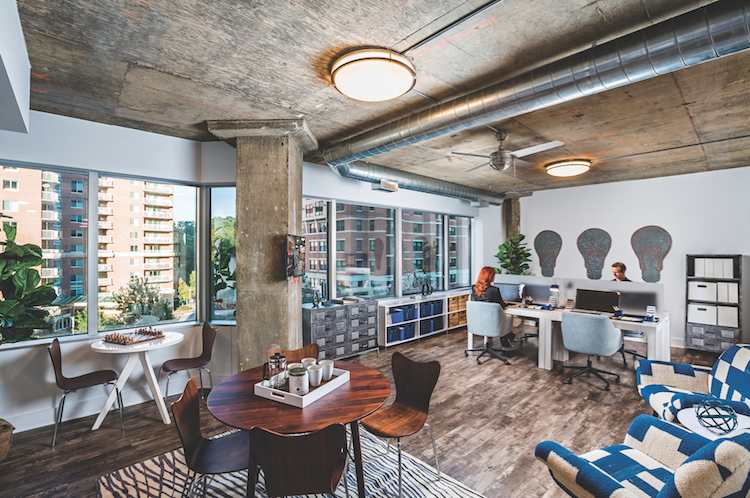 The loft-style one- and two-bedroom “live” or “live-work” units have 10-foot exposed ceilings, movable pocket walls, full-size washers and dryers, walk-in showers and soaking tubs, and Euro-style kitchens with pantries, quartz countertops, and bottom-drawer freezers. The “work” units have similar amenities, although the bedrooms are fitted for office use. Monthly rents run from $1,565 to $2,800 for one-bedrooms; two-bedrooms run $2,950/month.
The loft-style one- and two-bedroom “live” or “live-work” units have 10-foot exposed ceilings, movable pocket walls, full-size washers and dryers, walk-in showers and soaking tubs, and Euro-style kitchens with pantries, quartz countertops, and bottom-drawer freezers. The “work” units have similar amenities, although the bedrooms are fitted for office use. Monthly rents run from $1,565 to $2,800 for one-bedrooms; two-bedrooms run $2,950/month.
One place where they didn’t spend a lot of time or money: the façade. “The client wanted to put the emphasis on the interior,” says Shin.
On the exterior, the 30,000-sf parking garage roof gave Landworks Studio a chance to create a “cohesive experience, a living environment,” says Director of Design Mike Blier, ASLA, RLA, Hon. BSA. “It’s a kind of backyard, where we’ve programmed a range of amenities that everyone from individuals or couples up to large groups can enjoy.”
There’s a patio-with-pergola that leads to the indoor kitchen, a “beach” for lounging and sunbathing, and flex space for active sports like badminton, table tennis, or volleyball. “We used simple, honest materials, nothing too fancy,” says Blier. Catenary lighting lends what he calls “an outdoor living-room effect” to the environment.
The city issued final certificates of occupancy in December, and Novus has been averaging 20 leases a month since, says Seldin. “They’re exceeding the amount of nonresidential tenants that we anticipated,” says Kerns. “They’re getting a mix of uses. People are embracing the concept.”
Cafritz and Seldin have plans to invest $250 million in repurposing vacant office buildings into e-lofts. They’ve already spread the e-lofts gospel to neighboring Fairfax County, where they’re retrofitting a vacant office building into 156 e-lofts.
It took less than six months to convince Fairfax officials to change the zoning ordinance to allow as much as 100% residential in Planned Development Commercial Districts, up from 50%. To clinch the verdict, Seldin took Fairfax’s elected officials on a tour of the Alexandria e-lofts. “They were impressed,” he says.
PROJECT TEAM | E-LOFTS
Client: Novus Residences, LLC Architect: Lord Aeck Sargent Interior design/Visioning: Gensler Corridor Design: Carlyn and Company Interiors + Design Landscape architecture: Landworks Studio Structural engineer: Ellinwood + Machado Civil engineer: VIKA Mechanical/plumbing: Hurst Engineers Electrical: Cherry Lane Life safety/Fire protection: Freedom Fire Protection General contractor: Paradigm Contractors, LLC
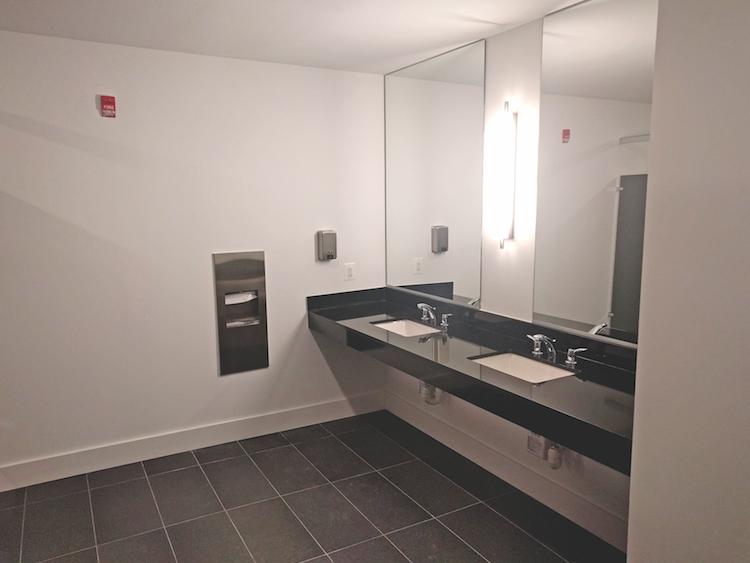 One amenity you won’t find in most apartment buildings: public toilets and water fountains in the hallways. The designers kept the originals to accommodate e-lofts businesses and their visitors. Courtesy Novus Residences
One amenity you won’t find in most apartment buildings: public toilets and water fountains in the hallways. The designers kept the originals to accommodate e-lofts businesses and their visitors. Courtesy Novus Residences
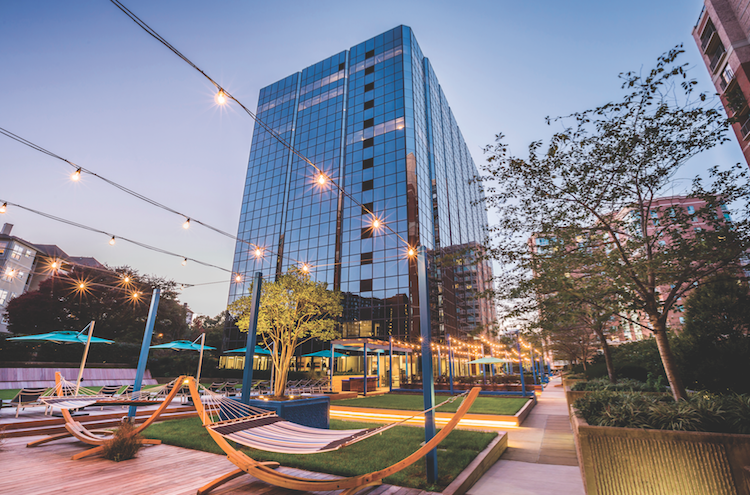 The 30,000-sf garage roof, with pergola-covered patio and outdoor dining area, can accommodate games, parties, and quiet leisure pursuits. Landworks Studio’s Mike Blier: “We used very simple materials—honest, nothing too fancy.” The deck helped meet Alexandria’s open space requirement.
The 30,000-sf garage roof, with pergola-covered patio and outdoor dining area, can accommodate games, parties, and quiet leisure pursuits. Landworks Studio’s Mike Blier: “We used very simple materials—honest, nothing too fancy.” The deck helped meet Alexandria’s open space requirement.
 The 2,000-sf club lounge is marked by formal wooden columns and soft furniture touches. Gensler’s Joanna Shin: “You can anchor yourself and work, have a lunch you’ve made in the nearby kitchen, or hold a small meeting.” Lord Aeck Sargent’s Warren Williams: “This is where visitors like to take selfies.”
The 2,000-sf club lounge is marked by formal wooden columns and soft furniture touches. Gensler’s Joanna Shin: “You can anchor yourself and work, have a lunch you’ve made in the nearby kitchen, or hold a small meeting.” Lord Aeck Sargent’s Warren Williams: “This is where visitors like to take selfies.”
Related Stories
| Aug 11, 2010
REDD and Corcoran Group Real Estate developing eco-friendly boutique condos in Brooklyn's Vinegar Hill
REDD and Corcoran Group Real Estate are developing 100 Gold, a 10-unit boutique condominium complex in Brooklyn's Vinegar Hill that consists of (6) one bedrooms, (2) duplex studios—one with a private yard, and (2) penthouses—duplex apartments with one bedroom and loft, and private terraces.
| Aug 11, 2010
AECOM, Arup, Gensler most active in commercial building design, according to BD+C's Giants 300 report
A ranking of the Top 100 Commercial Design Firms based on Building Design+Construction's 2009 Giants 300 survey. For more Giants 300 rankings, visit http://www.BDCnetwork.com/Giants
| Aug 11, 2010
Turner Building Cost Index dips nearly 4% in second quarter 2009
Turner Construction Company announced that the second quarter 2009 Turner Building Cost Index, which measures nonresidential building construction costs in the U.S., has decreased 3.35% from the first quarter 2009 and is 8.92% lower than its peak in the second quarter of 2008. The Turner Building Cost Index number for second quarter 2009 is 837.
| Aug 11, 2010
AGC unveils comprehensive plan to revive the construction industry
The Associated General Contractors of America unveiled a new plan today designed to revive the nation’s construction industry. The plan, “Build Now for the Future: A Blueprint for Economic Growth,” is designed to reverse predictions that construction activity will continue to shrink through 2010, crippling broader economic growth.
| Aug 11, 2010
PCL Construction, HITT Contracting among nation's largest commercial building contractors, according to BD+C's Giants 300 report
A ranking of the Top 50 Commercial Contractors based on Building Design+Construction's 2009 Giants 300 survey. For more Giants 300 rankings, visit http://www.BDCnetwork.com/Giants
| Aug 11, 2010
Webcor, Hunt Construction lead the way in mixed-use construction, according to BD+C's Giants 300 report
A ranking of the Top 30 Mixed-Use Contractors based on Building Design+Construction's 2009 Giants 300 survey. For more Giants 300 rankings, visit http://www.BDCnetwork.com/Giants
| Aug 11, 2010
Report: Fraud levels fall for construction industry, but companies still losing $6.4 million on average
The global construction, engineering and infrastructure industry saw a significant decline in fraud activity with companies losing an average of $6.4 million over the last three years, according to the latest edition of the Kroll Annual Global Fraud Report, released today at the Association of Corporate Counsel’s 2009 Annual Meeting in Boston. This new figure represents less than half of last year’s amount of $14.2 million.
| Aug 11, 2010
First CityCenter projects earn LEED Gold
CityCenter announced today that it has received three Leadership in Energy and Environmental Design LEED Gold certifications from the U.S. Green Building Council for: 1) ARIA Resort's hotel tower; 2) ARIA Resort's convention center and theater; 3) Vdara Hotel. ARIA and Vdara will open in December on the Las Vegas Strip and are the first of CityCenter's developments to be LEED certified.
| Aug 11, 2010
Oldcastle Precast Building Systems wins PCI 2009 Sustainable Design Award
Oldcastle Precast Building Systems was part of the award winning team behind the affordable housing development Melrose Commons Site 5 situated in the South Bronx. PCI (Precast Concrete Institute) recently selected Melrose 5 for the “2009 PCI Design Award for Best Sustainable Project”.


